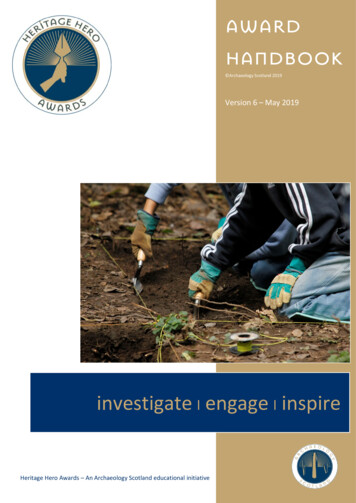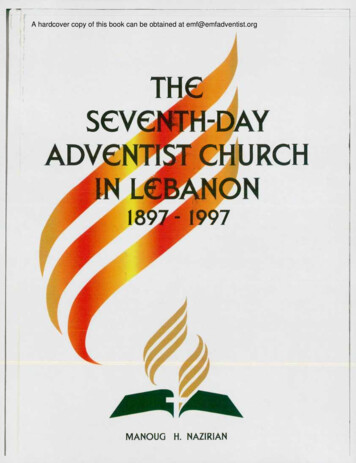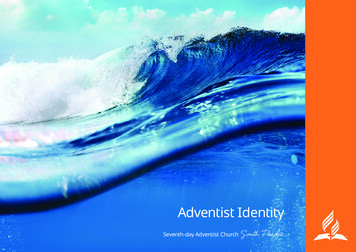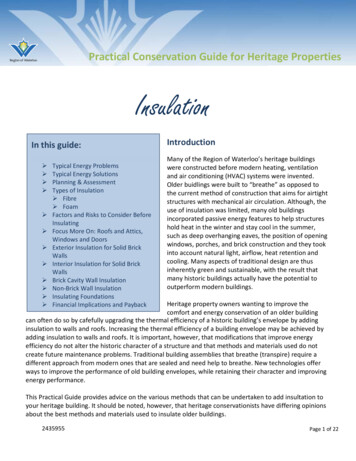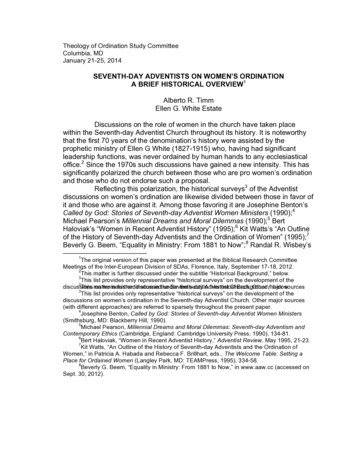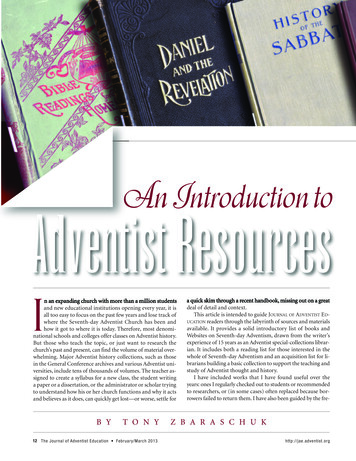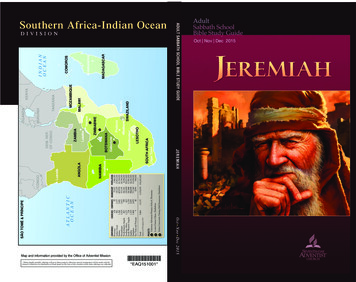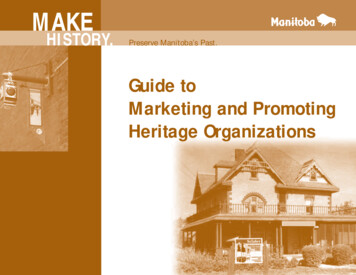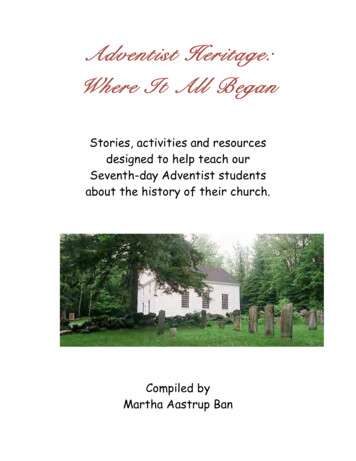
Transcription
Adventist Heritage:Where It All BeganStories, activities and resourcesdesigned to help teach ourSeventh-day Adventist studentsabout the history of their church.Compiled byMartha Aastrup Ban
Our Adventist HeritageTable o f C ontentsAdventist Heritage: . 1Where It All Began . 1Unit Overview . 4Where We Began . 11Henry White . 12Sojourner Truth . 15George Cobb . 25Falling Stars . 28Dark Day and Night . 30Nineteenth CenturyHealth Practices . 32Early Tent/Campmeetings . 36William Miller . 37Miller Chapel. 41Joshua Himes . 42Rachel Oakes . 43Frederick Wheeler . 44William Farnsworth . 45Cyrus Farnsworth . 46Washington N.H. Church. 47Jose ph Bates . 49William Foy . 51Ellen Gould Harmon White . 53James White . 55Hiram Edson . 57Hiram Edson’s BarnPort Gibson, New York. 60Leonard Hastings . 61John Byington . 62Martha Byington . 64John Loughborough . 66Atlantic Union Conference Teacher Bulletinwww.teacherbulletin.orgPage 2 of 109
Our Adventist HeritageJohn Andrews . 67Annie Smith . 69Uriah Smith . 70Horatio Lay. 73Stephen Haskell . 74John H. Kellogg. 76Mary Haskell . 78Three Prayer Bands and How They Grew . 78Goodloe Bell . 82Founders Hall . 84South Lancaster Academy . 88George King . 94Franklin Belden . 95Early Church Mu sic . 96A Chronology of Adventist Hymnody . 100Summary . 104Re sources . 106Atlantic Union Conference Teacher Bulletinwww.teacherbulletin.orgPage 3 of 109
Our Adventist HeritageUnit OverviewMany years ago, the Atlantic Union Conference Teacher Bulletin produced a resource unitfor teachers on Adventist History. Those materials are reprinted here – as part of acompilation of stories, activities and resources about our Seventh-day Adventistpioneers.Special thanks go to The White Estate (www.whiteestate.org/), and Adventist HeritageMinistry (http://www.adventistheritage.org/) for helping to update our information andfor giving permission to integrate their materials.Previous volumes of The Teacher Bulletin have additional units/resources.James White – Volume 1Pathways of the Pioneers - a four part series – Volumes 3, 4, 5, 6Targeted Grade Levels – Students are never too young or too old to learn about thehistory of their Church.Atlantic Union Conference Teacher Bulletinwww.teacherbulletin.orgPage 4 of 109
Our Adventist HeritageReprinted by permission of Adventist ReviewA large cross-generational group sat before me, all eager to claim the prizes I’d promisedto the first person to answer various questions on Adventist history. One knew that theAdventist Church was established in 1863; someone else guessed the name of the boatthat Edson White built and navigated to bring the gospel to recently emancipatedAfrican-Americans in the early post-Civil War South. A third claimed a T-shirt forguessing that Ellen White’s favorite pie was lemon!But then I stumped them.“I’d like someone under the age of 20 to answer this question,” I qualified, sure that Iwould be inundated with correct answers. “Who was the first president of the Seventhday Adventist Church?”After the under-20s had thudded erroneously right through the Big Three—JamesWhite, Joseph Bates, and J. N. Andrews—I opened the question to anyone, of any age.Though there were several pastors and Adventist teachers in the bunch, none had a clue.“John Byington,” I prompted. I received quizzical looks in response. I could have said“Thaddeus Mortimer Hornbuckle” and elicited as much recognition. (Current Adventistleaders fared no better. Though most of the adults knew the name of our currentGeneral Conference president, none of the children or youth did.)Adventist history. How much do we know about it, how much do our kids know, and does itmatter?Atlantic Union Conference Teacher Bulletinwww.teacherbulletin.orgPage 5 of 109
Our Adventist HeritageWhy Is This Important?No formal North American Division-wide studies have been done to determine the levelof Adventist history proficiency Seventh-day Adventist children possess, but it’sprobably safe to say our children could know more than they do about their faithheritage! This knowledge could be valuable to their spiritual growth as well as theirloyalty to God and the church. Students attending Adventist schools probably haveconsiderably more Adventist history knowledge than their counterparts in public schools,but even for them it is the sacred responsibility of parents, pastors, Sabbath schoolteachers, and Pathfinder/AY leaders to buttress and augment that knowledge. This wouldbe especially important for students who are not receiving an Adventist education.Why is Adventist history important? Our first clue comes from Hebrews 12:1, 2. After along recitation in chapter 11 of biblical heroes who kept the faith in spite of extremepressures to cast off their heritage, the writer of Hebrews uses his ubiquitous literarydevice—therefore—to notify the reader that the punch line is coming up:“Therefore, since we are surrounded by such a huge crowd of witnesses to the life offaith, let us strip off every weight that slows us down, especially the sin that so easilyhinders our progress. And let us run with endurance the race that is set before us” (Heb.12:1, NLT).*The Message (a Bible paraphrase) also reminds us of the importance of our faithancestry:“Do you see what this means—all these pioneers who blazed the way, all these veteranscheering us on? It means we’d better get on with it. Strip down, start running—and neverquit! No extra spiritual fat, no parasitic sins. Keep your eyes on Jesus, who both beganand finished this race we’re in. . . . In this all-out match against sin, others have sufferedfar worse than you, to say nothing of what Jesus went through” (Heb. 12:1-4, Message).†The biblical narratives remind us that there were scores of ancient heroes who lovedJesus enough to serve Him at great personal peril, sometimes even choosing to die ratherthan give up their faith. It’s inspiring and motivating to rehearse their fidelity. Godinstructed His ancient people to repeat often how He had intervened in their history (Ps.107:2; Ex. 12:24-27; Deut. 4:9). The stone that Samuel named “Ebenezer” was a visualreminder to the children of Israel of the day God’s thunderous voice had routed theirPhilistine enemies, thus saving the Israelites from certain destruction.Atlantic Union Conference Teacher Bulletinwww.teacherbulletin.orgPage 6 of 109
Our Adventist HeritageThere are also incredible stories of faith and heroism demonstrated in the lives of ourearly Adventist pioneers. Many of our spiritual ancestors endured bitter cold, oppressiveheat, rain, snow, poor-quality and scanty food, smoke-filled accommodations, andseparation from family in order to take the gospel to far regions by boat, sleigh, train,buggy, and foot. How did a handful of mostly nonwealthy visionaries build churches andestablish publishing houses, hospitals, and schools in the early days of our Adventistmovement? The miracle stories of God’s intervention coupled with the faith and sacrificeof His people abound!Commenting on the value of learning or reviewing Adventist heritage, Ellen White wrote:“In reviewing our past history, having traveled over every step of advance to our presentstanding, I can say, Praise God! As I see what God has wrought, I am filled withastonishment, and with confidence in Christ as leader. We have nothing to fear for thefuture, except as we shall forget the way the Lord has led us” (Christian Experience andTeachings of Ellen G. White, p. 204).“Again and again I have been shown that the past experiences of God’s people are not tobe counted as dead facts. We are not to treat the record of these experiences as wewould treat a last-year’s almanac” (Letter 238, 1903).“Like the people of Israel, let us set up our stones of witness, and inscribe upon them theprecious story of what God has wrought for us. And as we review His dealings with us inour pilgrimage, let us, out of hearts melted with gratitude, declare, ‘What shall I renderunto the Lord for all His benefits toward me?’” (The Desire of Ages, p. 348).“The past history of the cause of God needs often to be brought before the people,young and old, that they may be familiar with it. How frequently were the waymarks setup by the Lord in His dealing with ancient Israel, lest they should forget the history ofthe past” (Letter 33, 1890).Pass It OnThese statements make it evident that passing on the stories from Adventist history isimportant to God. But how do we pass on our spiritual heritage? What are some practicalways we can teach our kids Adventist history? Here are a few ideas: Tell Adventist heritage-themed stories for the Children’s Corner before the pastor’sSabbath sermon (see sidebar for resource ideas). This has the advantage of alsoeducating adults, since everyone loves a good story.Atlantic Union Conference Teacher Bulletinwww.teacherbulletin.orgPage 7 of 109
Our Adventist Heritage Download Visionary, an electronic magazine produced by the White Estate for kids ages8-14. Use it for family worship, Pathfinder devotionals, Sabbath school enrichment.(Don’t forget to check out the archived issues as well as the current issue.) If you live in or visit North America, take your children to visit Elmshaven, Ellen White’snorthern California home located near St. Helena, or Historic Adventist Village in BattleCreek, Michigan, or the first Seventh-day Adventist church at Washington, NewHampshire, which includes a mile-long “Sabbath” walk with extraordinary visuals along thepath. Hands-on learning in real time is valuable for all children, but may be especiallyvaluable for kinesthetic learners. Purchase and view the video/DVD series Keepers of the Flame, produced by the SouthPacific Division. Read the books listed in the accompanying sidebar with your children, either at home, inSabbath school, or at Pathfinders, and engage them in discussion of what it would havebeen like to be a participant in that story. Encourage your children to describe what itwould have felt like, tasted like, looked like, smelled like, and sounded like to have beenthere. Purchase the audio dramatized Adventist Heritage CDs titled Pathways of the Pioneers.(These can be purchased at your local Adventist Book Center or online atwww.adventistbookcenter.com.) Encourage your children to access www.adventistheritage.org to take virtual tours ofAdventist heritage sites and see pictures of our pioneers. This will be more meaningful ifyou have read stories together about the pioneers pictured at the site.Now, let’s quit talking about history and close with a relatively recent story from ourAdventist heritage.A True StoryMother Brooks lay wide-awake and worried in her darkened hospital room. Who wouldtake care of her 10 children? Most were in school, so who would care for the baby?Mother Brooks felt helpless and anxious.In her distress, this godly African-American mother turned her thoughts toward herSavior. He had helped her so much in the past. She began praying for her children, namingeach one.Atlantic Union Conference Teacher Bulletinwww.teacherbulletin.orgPage 8 of 109
Our Adventist HeritageAs she lay there praying quietly, Mother Brooks suddenly heard a voice, a voice sheimmediately sensed came from God.“Keep My commandments,” the voice said.Mattie sat up, startled. “Which one am I not keeping?” she asked.In her mind she saw the Ten Commandments. One stood out from the rest. One was largeand very clear. It was the fourth commandment.“. . . Six days shalt thou . . . do all thy work: but the seventh day is the Sabbath . . .”Mother Brooks was astonished. The seventh day was Saturday. She’d been keepingSunday. But what did this have to do with the things she’d been praying about? What didkeeping the seventh day have to do with saving the children for eternity and getting herhealth back? Mattie Brooks would soon discover that that simple message had a lot to dowith both her health and her children’s salvation.Mother Brooks had always been a devout Sundaykeeper. Now that she felt she had beenhonoring the wrong day, she promised the Lord she’d start observing the seventh-daySabbath and teach her children to do so, too.Soon Mother Brooks returned home from the hospital. For the next seven years she andthe children kept the Sabbath. Since she had no idea that anyone else kept that daysacred, she still maintained her membership in her Sunday church. But everywhere shewent, people scoffed at and scorned her. Finally her own church decided to act. Adelegation of leaders came to bring Mother Brooks “back into the fold.”The senior deacon led the group who came that night to straighten out Mother Brooks.First they pled with her to consider her denomination’s heritage, and stated that surelyall her beloved preacher-ancestors couldn’t have been wrong about what day they kept.When that didn’t change her mind, the deacons began to try to prove that God had notcommanded to honor the seventh-day Sabbath in Scripture.But by this time Mother Brooks was an excellent Bible student! She didn’t argue with thedeacons—instead, she asked “innocent” questions that so confused her interrogators theycould find no answers. Finally, confused and upset, the deacons rose to leave.When all had filed out the door except the senior deacon, he turned back and pulled aAtlantic Union Conference Teacher Bulletinwww.teacherbulletin.orgPage 9 of 109
Our Adventist Heritagebrown paper bag from under his coat. He handed it to Mother Brooks.When he had gone, the children clustered around their mother. She carefully opened thepackage. Inside was a large, bound volume of The Great Controversy. It was written byEllen G. White, someone they’d never heard of. Right away they began to read, and Godspoke to the family again, this time through the pages of a book.Young Charles had not yet reached 10 years of age, but his interest in that book wastremendous. Here were heroes any boy could admire—Huss; Jerome; Luther, who defiedemperors and popes; and Wycliffe, the Bible smuggler. He read about the Waldensianshiding in the caves of the Piedmont Mountains with their handwritten Bibles. As Motherread, the message of the great struggle between Christ and Satan became very clear toCharles and the other children. They began to understand the Sabbath as a flag ofloyalty under which Christ’s troops must march.Mother Brooks determined to find out more about the people who wrote the book. Beforelong she and the children joined the Adventist Church. Seven years later, to their greatjoy, Father also became a baptized Seventh-day Adventist. Now the whole family waskeeping God’s Sabbath. Mother Brooks believed that the Voice that had spoken to her inthat hospital room was the same Voice she heard speaking to her heart through EllenWhite’s books.Young Charles never forgot that he was part of the great fight between good and evil.When he grew up, he became a pastor, an evangelist, and eventually a General Conferenceminister known and loved throughout the world as a champion for Jesus Christ. To thisday, C. D. Brooks still regards Ellen White as a personal friend whose words were as God’svoice to his family.‡*Scripture quotations marked NLT are taken from the Holy Bible, New Living Translation, copyright 1996. Usedby permission of Tyndale House Publishers, Inc., Wheaton, Illinois 60189. All rights reserved.†Texts credited to Message are from The Message. Copyright ” 1993, 1994, 1995, 1996, 2000, 2001, 2002. Usedby permission of NavPress Publishing Group.‡Adapted from The Spirit of Prophecy Emphasis Stories, Vol. II, prepared jointly by Norma Youngberg, FernBabcock, The Ellen G. White Estate, and the General Conference Department of Education, 1982.Atlantic Union Conference Teacher Bulletinwww.teacherbulletin.orgPage 10 of 109
Our Adventist HeritageWhere We BeganAtlantic Union Conference Teacher Bulletinwww.teacherbulletin.orgPage 11 of 109
Our Adventist HeritageHenry WhiteHave you ever had an impression or dream that resulted in your sensing something wasgoing to happen? James and Ellen White did. The Whites had been working in Michiganfor a long time. Ellen wanted to return home to see the children and complete themanuscript of the third volume of Spiritual Gifts. James wanted to escort his wife homeand check that the children were all right. It was during a stop-over in Brookfield thatJames White had a dream which troubled him. There was no apparent cause to worryabout their three boys. Letters from Topsham, ME stated that everyone was well.Nevertheless, both parents were worried. They wanted to check on their boys in person.The Whites finally arrived at the train depot in Topsham, ME on Friday, November 27,1873. The three boys and their nurse joyfully welcomed them. Everyone seemed to bewell, with the exception of Henry. He had a cold.As the days went by, it was obvious that Henry’s cold was getting worse. By the fourthday since his parents’ return, Henry’s condition was diagnosed as pneumonia. Either virusesor bacteria that attack the body and inflame the lungs cause pneumonia. A doctor wascalled and he prescribed highly poisonous medicines. They were the usual treatment forpneumonia. James and Ellen White had used hydrotherapy (water treatments) on Willieand Edson when they had diphtheria earlier that year. However, they felt that pneumoniashould be treated by the usual methods of their day.Even with the medication, Henry got worse. The Whites and Howlands took turns caringfor him. They prayed and prayed for Henry to recover, but Henry did not get better.James and Ellen did not give up. They decided to talk to Henry about death. Theydiscussed with him the possibility that he might die. It was wonderful to see Henry’s faithin Jesus. He confessed to his family his regret that he did not take the Christian lifeseriously. He knew that he did not set a good example during the time they lived in BattleCreek, MI. He talked to his brothers about his life and his growing commitment to God.His testimony helped his brothers cope with the eventuality of his death. Henry believedhe had made peace with God and was looking forward to eternal life when he would beresurrected.While Ellen attended him one morning, he spoke to her. “Promise me, Mother, that if I dieI may be taken to Battle Creek, and laid by the side of my little brother, John Herbert,that we may come up together in the morning of the resurrection.” AY, p. 26.His mother promised to do what he asked. Ellen must have had tears in her eyes. Shemust have felt deep sorrow about the loss of a second child, yet happy that Henry wantedto be with his brother on resurrection morning.Atlantic Union Conference Teacher Bulletinwww.teacherbulletin.orgPage 12 of 109
Our Adventist HeritageJames White would often go to a private place to pray during Henry’s illness. When hiscourage seemed to fail, he would pray. On one occasion he felt so full of grief that hehad to pour his heart out to God. After his time of prayer he knew that God was leadingand everything would work for the best. He shared his thoughts with Henry. His son’s faceseemed to shine with a “heavenly smile.” Henry was so weak that he could only nod andwhisper, “Yes, He will.” AY p. 27On another occasion Henry said to his father, “Father, you are losing your son. You willmiss me, but don’t mourn. It is better for me. I shall escape being drafted, and shall notwitness the seven last plagues. To die so happy is a privilege.” AY, p. 29Just before he died he spoke to Ellen. “Mother, I shall meet you in heaven in the morningof the resurrection, for I know you will be there.”After these words he asked his brothers, parents and friends tocome to his side. He kissed each person present then pointedupwards and whispered, “Heaven is sweet.” AY, p. 31. Thosewere his last words.Can you imagine the sorrow each person present at Henry’sdeath must have felt? Yes, they missed him. They admired theinner strength Henry showed through the illness. He was oftenin pain, often weak, yet his faith in God strengthened his mind.He was able to make people laugh. He was able to comfort hisbrothers and parents. He was truly a blessing to his family.Who was Henry White? He was the first son of James and Ellen. His parents referred tohim as the “sweet singer.” Henry was gifted. He played several instruments and sangbeautifully. He enjoyed school and excelled in it. Most importantly, he had a greatpersonality. He was funny. He reminded his father that he would be escaping the draft tothe army when he died. Henry also cared about his friends. During his illness he dictatedmessages to his Battle Creek friends. He lifted their spirits and urged them to get closerto God.Henry was only 16 years old when he died. Some people may have said that he was tooyoung. Yet when one sees how much he helped his family and friends one can say he didmore in his young life than many people who live to be eighty years of age and older.What caused Henry’s illnesses? Willie, his youngest brother, remembered that both Henryand Edson were helping Brother Stockbridge Howland. They were mounting charts on clothin preparation for sales. They had a short break while waiting for charts to arrive fromBoston. The brothers would tramp down to the river. One day Henry decided to take a napafter he returned from a trip to the river. He went to sleep on layers of damp cloths usedAtlantic Union Conference Teacher Bulletinwww.teacherbulletin.orgPage 13 of 109
Our Adventist Heritagefor the charts. He fell asleep in the draft of a cold wind blowing through a nearbywindow. This resulted in the terrible cold he got.Funeral ServicesHenry’s friends in Topsham requested permission from Ellen and James White to hold afuneral service in their town. They arranged times with the Baptist clergy across thestreet. M.E. Cornell officiated at the service.After the service, the White family traveled west to Battle Creek. Henry’s body wastaken in a metal casket. Uriah Smith officiated at the funeral service in Battle Creek. TheWhites were comforted by their friends and Henry’s friends. It was an especially movingpart of the service when Henry’s classmates sang a hymn during the closing. Theyaccompanied the family and friends to the Oak Hill Cemetery where Henry was buried nextto his brother.“When our noble Henry died, at the age of 16 – when our sweet singer was borne to thegrave, and we no more heard his early song – ours was a lonely home. Both parents andthe two remaining sons felt the blow most keenly. But God comforted us in ourbereavements, and with faith and courage we pressed forward in the work He had given us,in bright hope of meeting our children who had been torn from us by death, in that worldwhere sickness and death will never come.” 3LS, p. 165, 166The resting place of theWhite family in Oak HillCemetery. In the foregroundare the headstones markingJames and Ellen White’sgraves.Atlantic Union Conference Teacher Bulletinwww.teacherbulletin.orgPage 14 of 109
Our Adventist HeritageSojourner TruthAt an undetermined date in Ulster County, NY, a baby girl was born to slaves. She wasthe daughter of slaves and the property of slave masters. This baby girl was namedIsabella. Everyone who knew her called her Belle. Little did Isabella’s owners or parentsknow of the impact her life would make.Belle and her parents were the property of a Dutch landowner, Charles Hardenbergh. Itis said they owned about 2 million acres of land between the Hudson and Delaware Riversin New York.Belle’s life began in the cellar of the Hardenbergh’s home. It was damp and dark downthere. When it rained the cellar would become muddy. The boards they slept on would besaturated. As you might imagine the slaves were not living in healthy conditions. The lackof a clean dry place to live produced crippling diseases such as: arthritis, rheumatism, andtuberculosis.Isabella’s first language was West German. Her mother’s low-Dutch name was Mau-MauBett. Her father was called Baumfree, which translated as “tree.” Most slaves spoke thelanguage of their owners. Whereas many people were immigrating to the New World, theyoften did not need to learn a new language if they settled in a community of the sameheritage or ethnic background.Slave families were often not allowed to stay together. Most owners would sell theweakest and youngest. Bell’s older brothers and sisters were sold when they were veryyoung. She remembered her mother’s sorrow at the loss of her children. She lived inconstant fear of being sold.The day finally came for Belle to leave the only home she had ever known. Her masterdied and the property was to be divided among the owner’s family or sold for cash. It wasin 1806 that Belle first faced the inhuman, degrading experience of an auction. She wassqueezed and examined all over by merchants. She felt so alone. She could notunderstand why she was treated like the animals in holding pens. Was she not a personlike the white merchants and her former owners?Belle was not a pretty child. She was thin and tall when
northern California home located near St. Helena, or Historic Adventist Village in Battle Creek, Michigan, or the first Seventh-day Adventist church at Washington, New Hampshire, which includes a mile-long “Sabbath” walk with extraordinary visuals along the path. Hands-on learning in real
